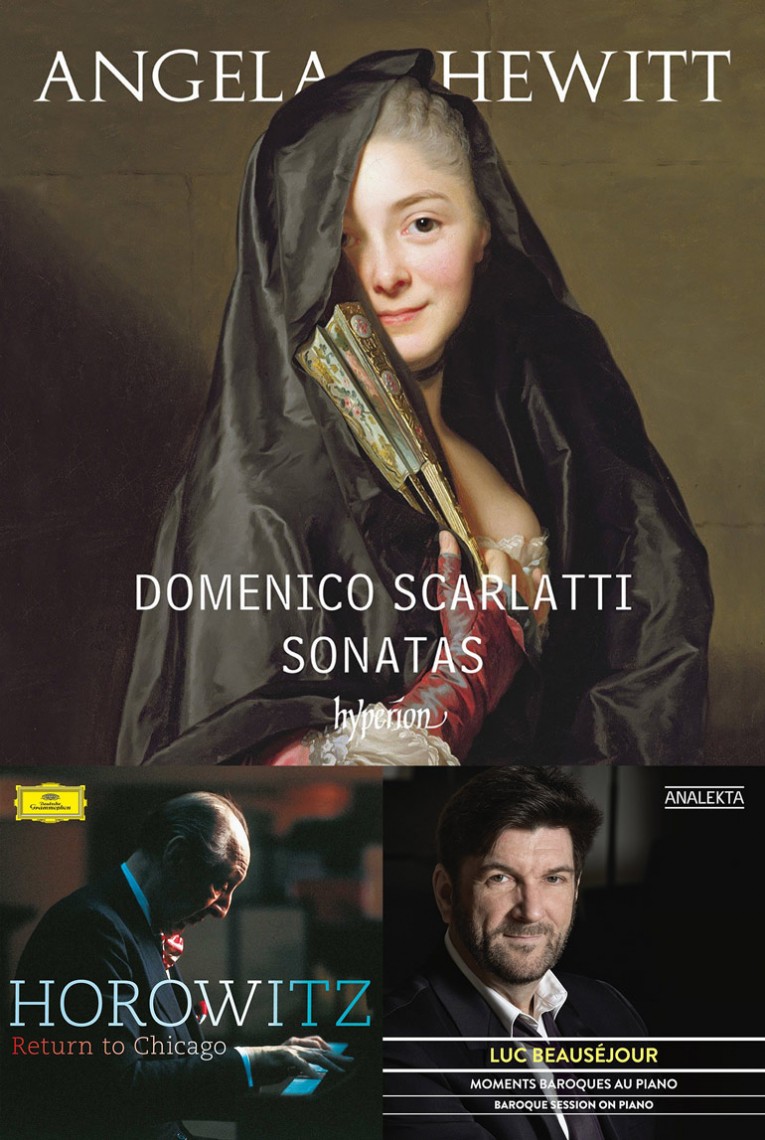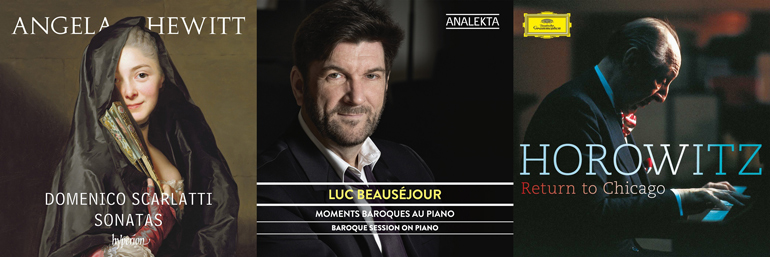Three new CD releases by piano heavyweights Angela Hewitt, Luc Beauséjour, and Vladimir Horowitz.

Angela Hewitt (piano) Scarlatti: Sonatas (16). (Hyperion); Total Time: 76.10.
Luc Beauséjour (piano) Moments Baroque au Piano (Analekta); Total Time: 64.00.
Vladimir Horowitz (piano) Horowitz: Return to Chicago (DG). Total Time: 121.38.
When Martha Argerich made a rare appearance in Montreal recently (Feb/2016), she played Scarlatti’s Sonata in D minor K141 as an encore. It was wonderful, to say the least. Shortly after viewing this live broadcast by the Orchestre symphonique de Montréal, I received all three review recordings listed above. As Hewitt’s CD is an all-Scarlatti album, and each of the others includes several Scarlatti sonatas, I thought it might be interesting to compare them.
Hewitt is the only one who plays the K 141. It is almost unfair to compare anyone else’s performance with one by Argerich, but to my surprise and delight, Hewitt’s was very competitive – if one can use that word when discussing an artist’s work. In the famous mandolin-inspired repeated note passages, her playing is as flawless as that of Argerich and overall she plays Scarlatti with style and subtlety.
Hewitt and Horowitz both play the Sonata in E major K 380 – a charming little march – but they approach it differently. Hewitt takes it much slower, as if keen to emphasize the underlying sadness of the music. And while Horowitz omits the second repeat, Hewitt plays both repeats. The fingering of Horowitz, aged 83, comes across as a little nervous and uneven.
We can compare Hewitt and Beauséjour in the Sonata in C major K 159. Beauséjour is primarily a harpsichordist – and a very good one too – and it shows by comparison with Hewitt. More restrained in his use of dynamics, he seems to be trying to emulate the harpsichord and its limitations on the piano. Hewitt recognizes no such limitations and never hesitates to make a crescendo or use the greater dynamic range of the piano if the music seems to benefit from it. On the whole, Hewitt plays K 159 with more authority than Beauséjour.
Angela Hewitt’s all-Scarlatti CD is a joy to listen to from beginning to end, and I expect to return to it often. In her hands, each of these brief pieces has a character all its own. Her notes are also very helpful for any listener with an interest in specifics about each of these sonatas.
Luc Beauséjour’s notes are also perceptive and informative, especially on the subject of what makes the harpsichord different from the piano.
The Horowitz 2-CD set from DG is a must-have for Horowitz fans although it mostly traverses repertoire that the great Ukrainian pianist had often done before. His performances could be uneven – especially in his later years – but invariably, he would burst forth with playing that was unique in its power and intensity. In this live Chicago concert performance, Scriabin’s Étude in D sharp minor Op. 8 No. 12 alone is worth the price of the album. Recorded by WFMT, this CD set includes two interviews, one recorded the day before the 1986 concert and the other dating back to 1974, around the time of another Horowitz appearance in Chicago.

- Angela Hewitt Scarlatti: Sonatas is available from Amazon.com and iTunes.
- Luc Beauséjour Moments Baroque au Piano is available from Amazon.ca and iTunes.
- Horowitz: Return to Chicago is available from Amazon.com and iTunes.
#LUDWIGVAN
Want more updates on Toronto-centric classical music news and review before anyone else finds out? Get our exclusive newsletter here and follow us on Facebook for all the latest.
- SCRUTINY | TSO Lets Berlioz Do The Talking In Season Opener - September 21, 2018
- RECORD KEEPING | Even Yannick Nézet-Séguin Can’t Make Us Love Mozart’s La Clemenza di Tito - September 6, 2018
- RECORD KEEPING | Giovanna d’Arco With Anna Netrebko Explains Why The Best Operas Survive - August 30, 2018



